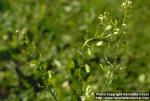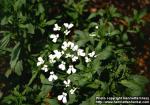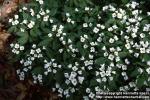Capsella.—Shepherd's Purse.

 The dried plant of Capsella Bursa-pastoris, Moench (Thlaspi Bursa-pastoris, Linné).
The dried plant of Capsella Bursa-pastoris, Moench (Thlaspi Bursa-pastoris, Linné).
Nat. Ord.—Cruciferae.
COMMON NAMES: Shepherd's purse, Shepherd's sprout.
ILLUSTRATION: American Dispensatory, 8th ed., Plate 5.
Botanical Source.—This is an annual weed, the stem of which is erect, striate, about 12 inches high, where the plants grow apart, but in rich soil, where they are in patches, the stems are often over 2 feet long, and reclining, but the thickness is increased very little. The branches are few, remote, and generally simple. The leaves are mostly borne in a thick radical cluster, at the base of the stem, and recline on the ground. They are from 3 to 6 inches long, and pinnatifid, with from 9 to 15 acute, wedge-shaped segments. The stem leaves are few, shorter than the internodes, and clasp the stems at the base of the branches. The lower stem-leaves are sagittate and dentate; the upper, linear and entire. The flowers are small, white, and borne in terminal racemes, which elongate as the flowers expand. The sepals and petals are 4, and the stamens are 6 and tetradynamous. The fruit is a flat, wedge-shaped pod, notched at the end, and divided by a narrow partition, into 2 cells, which contain numerous minute, oblong seeds.
 History.—Shepherd's purse is a native of Europe, but is naturalized in almost every country of the world. In the United States it has become among the most common of yard weeds, growing in all sections of the country, and forming large patches in waste grounds. It is especially luxuriant in the spring months, but the stem dies and the weed entirely disappears by the middle of summer. It is often eaten in the spring as "greens."
History.—Shepherd's purse is a native of Europe, but is naturalized in almost every country of the world. In the United States it has become among the most common of yard weeds, growing in all sections of the country, and forming large patches in waste grounds. It is especially luxuriant in the spring months, but the stem dies and the weed entirely disappears by the middle of summer. It is often eaten in the spring as "greens."
Capsella Bursa-pastoris has been used in domestic medicine since an early day. Culpepper refers to it in his English Physician, and the article is copied almost verbatim in subsequent works, until Lewis' (1761) Materia Medica cast discredit upon it as an astringent.
Description and Chemical Composition.—Shepherd's purse has been described above (Botanical Source). It has an herbaceous, unpleasant odor when fresh, if bruised, and a pungent, biting taste, which is lost by drying. The herb contains a resin and a volatile oil; the seeds yield proteid substances, a fixed oil, and a volatile oil said to be identical with the volatile oil of mustard. But no satisfactory analysis has yet been made of its chemical constituents.
Action, Medical Uses, and Dosage.—Shepherd's purse appears to possess mild stimulating, astringent, and diuretic properties, and the fresh herb is decidedly more active than the dried. In urinary derangements of renal or cystic origin, and in hematuria, an infusion, and especially a tincture of the herb, will be found very efficient. It has likewise been used with some success as an expectorant and for the promotion of the catamenial flow in cases of simple amenorrhoea. It is a remedy for chronic menorrhagia, with too frequent and too long-continued or constant, but almost colorless, flow. Associated with this condition is a frequent urging to urinate, and a deposit of phosphates. Atonic dyspepsia and chronic diarrhoea have been successfully treated with it. In bleeding piles, diarrhoea, and dysentery, it is stated to have been found beneficial. The dose of the infusion is from 2 to 4 fluid ounces, but its best forms for administration are the specific medicine, a tincture, or fluid extract of the herb; the dose of the tincture is 1 or 2 fluid drachms every 2 or 3 hours; of the fluid extract, from 20 to 60 minims; of specific capsella, 1 to 30 drops. The fresh herb, bruised and applied locally, has been effectual in ecchymosis, the result of blows, bruises, etc., and has been of service in rheumatic pains.
Specific Indications and Uses.—Chronic hemorrhages; menorrhagia with too frequent and long continued, or constant, colorless discharge; indigestion from atony; chronic diarrhoea; constant desire to urinate, with deposits of phosphates.
Related Species.—Lepidium virginicum, Linné. Pepper-grass, Tongue-grass.—An allied weed found in similar locations, has often been confounded with capsella, and has been lately figured for it in one of the medical journals. Pepper-grass has an erect, much-branched stem, about a foot high. The leaves are numerous and much more toothed than the stem leaves of capsella. The fruit is an orbicular, flattened pod, divided into 2 cells by a narrow partition, and containing 2 rather large seeds. Pepper-grass has a much sharper and more pungent taste than capsella. This and the next species probably contain a sulphuretted essential oil.
Lepidium intermedium, Gray; North America. Wild pepper-grass.
Lepidium sativum, Linné, Garden pepper-grass, Garden cress.—Habitat, Asia. Cultivated in Europe and America for table use. Contains a volatile, sulphuretted oil, and myrosin.
Lepidium campestre, Linné, Yellow-seed, and Lepidium ruderale, Linné, Pepper-grass.—Acrid plants with the same constituents as the preceding species.
Lepidium Iberis, Linné, Pepper-grass.—Southern Europe to northern Asia. Contains lepidin, a bitter, amorphous body obtained from the flowers and seeds (Leroux, 1837), and a volatile, sulphuretted oil.
Lepidium latifolium, Linné, Broad-leaved pepper-wort.—Properties similar to last species.
 Thlaspi arvense, Linné, and Thlaspi campestris, Linné. Europe and America; known as Penny cress and Mithridate mustard; have brown, alliaceous seeds which yield an oil which Pless declares to be a mixture of oils of mustard and garlic.
Thlaspi arvense, Linné, and Thlaspi campestris, Linné. Europe and America; known as Penny cress and Mithridate mustard; have brown, alliaceous seeds which yield an oil which Pless declares to be a mixture of oils of mustard and garlic.
 Iberis amara, Linné, Bitter candy-taft.—This plant has a herbaceous stem about a foot in height, with lanceolate, acute, somewhat toothed leaves, and white flowers, corymbed, but becoming racemed. Silicles obcordate, narrowly emarginate; cells 1-seeded (W). This is a small annual, common to Europe, where it is admired as an ornamental plant; its beautiful white flowers appearing in June and July. The whole plant is reputed medicinal, the seeds more especially. In overdoses it occasions vertigo, vomiting, and purging, without accomplishing any valuable result. Medicinally, it appears to control nervous and vascular excitement, and has been found efficient in enlargement of the heart, and some affections of the air-tubes. It is also said to have been beneficially administered in rheumatic, gouty, and dropsical affections. The dose is from 1 to 5 grains of the powdered seeds.
Iberis amara, Linné, Bitter candy-taft.—This plant has a herbaceous stem about a foot in height, with lanceolate, acute, somewhat toothed leaves, and white flowers, corymbed, but becoming racemed. Silicles obcordate, narrowly emarginate; cells 1-seeded (W). This is a small annual, common to Europe, where it is admired as an ornamental plant; its beautiful white flowers appearing in June and July. The whole plant is reputed medicinal, the seeds more especially. In overdoses it occasions vertigo, vomiting, and purging, without accomplishing any valuable result. Medicinally, it appears to control nervous and vascular excitement, and has been found efficient in enlargement of the heart, and some affections of the air-tubes. It is also said to have been beneficially administered in rheumatic, gouty, and dropsical affections. The dose is from 1 to 5 grains of the powdered seeds.
Cochlearia officinalis, Linné, Scurvy-grass, Spoonwort (Herba cochleariae). Europe. An acrid, bitterish, pungent plant when fresh. It contains the common plant constituents with a bitter body, tannin, salts, and gives rise to an essential oil (oil of scurvy-grass), not pre-existent in the plant. A. W. Hoffmann demonstrated that it was composed mainly of butyl-iso-sulphocyanide (CSN.C4H9). An oil of like composition, but having a different odor, is synthetically prepared from butylamine (C4H9.NH2). It differs also in the fusing point of the addition compound it forms with ammonia, 90° C. (192° F.), while the corresponding compound of the former (CS.[NH2].NH[C4H9]), melts at 135° C. (275° F.). The plant is sometimes used as a salad. It is stimulant, antiscorbutic, and diuretic. It is very valuable in scurvy when eaten fresh, and the juice in water makes a good wash for spongy gums and buccal ulcerations.
 Cardamine pratensis, Linné, Cuckoo-flower (Herba nasturtii pratensis).—A bitterish, pungent perennial found in Asia, Europe, and sparingly in North America. The showy flowers are of a white or rose color. The virtues of the plant are due to an essential oil, probably analogous to oil of mustard, as the seeds are said to contain myronic acid. The characteristics of the plant are lost upon drying. Diuretic, antispasmodic, and antiscorbutic. Has been used in chorea, asthma, dropsy, bronchitis, intermittent fever, laryngitis, and scaly skin affections, and locally to cancer and other sores.
Cardamine pratensis, Linné, Cuckoo-flower (Herba nasturtii pratensis).—A bitterish, pungent perennial found in Asia, Europe, and sparingly in North America. The showy flowers are of a white or rose color. The virtues of the plant are due to an essential oil, probably analogous to oil of mustard, as the seeds are said to contain myronic acid. The characteristics of the plant are lost upon drying. Diuretic, antispasmodic, and antiscorbutic. Has been used in chorea, asthma, dropsy, bronchitis, intermittent fever, laryngitis, and scaly skin affections, and locally to cancer and other sores.
Cardamine hirsuta, Linné. Small bitter cress of Europe and North America, and Cardamine amara, Linné, Bitter cress of Europe, have properties somewhat like the preceding.
Continued on next page.

